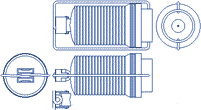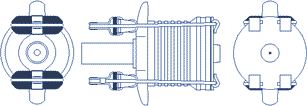With a selection of seven basic models – and for some, a number of variations – the Jetex range offered modellers a rich choice of powerplant.
Beginning in 1948 with the release of the Jetex 100 and 200 motors, Wilmot Mansour and Co. Ltd. continued expanding the range over ensuing years. The final additions came in 1953 with the introduction of both the smallest, the Atom 35, and the largest, the Scorpion 600.
The model numbers given to each were intended to indicate thrust – for example, the Atom 35 was rated at 0.35 oz. and the Scorpion 600 at 6 oz.
On this page, you'll find details of each motor in the range, with a link to a further page of information.
JETEX ATOM 35
{modal url=index.php?option=com_content&view=article&id=17|width=500|height=350} {/modal}
{/modal}
Although the Atom 35 was the baby of the family of Jetex motors, it was one of the last to be introduced by Wilmot Mansour, in 1953.
More than its siblings, it tended to suffer from blow-back. Most pellets were a tight fit in the main case. Being of thin gauge, it was easily dented, making loading more difficult. These annoyances, and its relatively short duration, led to fewer modellers interested in using this motor. READ MORE
Click image to enlarge
JETEX 50 (Original)
{modal url=index.php?option=com_content&view=article&id=18|width=500|height=350} {/modal}
{/modal}
As the most popular unit of the range, the Jetex 50 underwent a succession of developments and modifications (see next item). The original (a.k.a. standard) 50, had a turned ribbed main case and end caps.
Sensing a demand for a smaller addition to the range, Wilmot Mansour brought it to the market in their second year of production, in 1949. Production was phased out in favour of the later versions, in 1954. READ MORE
Click image to enlarge
JETEX 50B/C/Export
{modal url=index.php?option=com_content&view=article&id=29|width=500|height=350} {/modal}
{/modal}
For the the U.S. market, Wilmot Mansour introduced the Export 50. From this evolved the 50B, a longer motor with more free space for combustion and to aid wick ejection. Both differed from the standard 50 in that they had a pressed alloy case and a dome shaped end cap, which favoured the use of an augmenter tube.
When Jetex manufacture was taken over by D. Sebel Co. Ltd., the 50C was added to the range. It retained the shape of the 50B, but was made of steel throughout. However, while it proved more durable, it still required as much attention, if not more, than the 50B in order to avoid corrosion. READ MORE
Click image to enlarge
Jetex 50R (aka 50HT in the US)
{modal url=index.php?option=com_content&view=article&id=30|width=500|height=350} {/modal}
{/modal}
This boosted-thrust dual-spring motor was introduced by Wilmot Mansour in 1955 and marketed in the UK as the 50R (‘R’ for ‘rocket’). It was brought to the US market by Telasco in 1963 as the 50HT (‘HT’ for ‘high thrust’).
It used fuel prepared in such a way that it burned at a much faster rate than in the 50C, thus achieving significantly higher thrust – 5-6 oz for up to 4 seconds was claimed. READ MORE
Click image to enlarge
Jetex 100
{modal url=index.php?option=com_content&view=article&id=31|width=500|height=350} {/modal}
{/modal}
One of the pioneers of the range (along with the Jetex 200) in 1948, the Jetex 100 had a turned, rather than drawn, case. To provide for safety release, it employed three helical springs, which could make loading troublesome.
Despite its popularity, the 100 was eventually phased out in 1954, in favour of the Jetmaster. READ MORE
Click image to enlarge
Jetex Jetmaster
{modal url=index.php?option=com_content&view=article&id=32|width=500|height=350}.gif) {/modal}
{/modal}
The Jetmaster was introduced in 1952, using the same fuel as the Jetex 100 and able to take an additional half fuel pellet, thus increasing the duration to 22 seconds.
Loading was easier than the 100, with only a single spring to retain the end cap, which was designed as a matching fit for an augmenter tube. However, cleaning was less straightforward, owing to the many parts that required disassembling. READ MORE
Click image to enlarge
Jetex 150 PAA-Loader
{modal url=index.php?option=com_content&view=article&id=33|width=500|height=350} {/modal}
{/modal}
The Jetex 150 was produced by D. Sebel Co. Ltd, after Jetex manufacture passed to them in 1956. It acquired its PAA-Loader designation from its association with the Pan American Airways-sponsored international duration contest, where it had a class to itself.
Having a longer body, with a single retaining spring clip, it could take up to three Jetex 150 fuel pellets. It achieved a high degree of popularity, and was the inspiration for many fine duration designs. READ MORE
Click image to enlarge
Jetex 200
{modal url=index.php?option=com_content&view=article&id=34|width=500|height=350} {/modal}
{/modal}
One of the two initial motors to be marketed (along with the Jetex 100) in 1948, the Jetex 200 also had a turned case.
With five coil springs for end cap retention (as compared to the three of the Jetex 100), it proved similarly troublesome to load and did not achieve a high level of popularity. As evidence of its relative obscurity, there are very few surviving model plans. READ MORE
Click image to enlarge
Jetex 350 / Spacemaster 600A
{modal url=index.php?option=com_content&view=article&id=35|width=500|height=350} {/modal}
{/modal}
The Jetex 350 joined the range in 1948, shortly after the 100 and 200 models. It acquired its rather ambitious 'Spacemaster 600A' designation when it was marketed in the US by American Telasco Ltd.
Known as "a strong man's motor", it required a lot of effort to remove the five springs, but with a duration of 36 seconds (on three charges) it was popular for duration flying. READ MORE
Click image to enlarge
Jetex Scorpion 600
{modal url=index.php?option=com_content&view=article&id=36|width=500|height=350} {/modal}
{/modal}
The Scorpion was the most distinctive and powerful motor in the Jetex range. The 600 (= 6 oz. of thrust) designation was rather ambitious, with tests showing an average of 5 oz., for 8-9 seconds duration. With just two spring rollers which snapped easily into place, it had the attractions of easy loading and a tubular end mount for simple model attachment. First marketed in 1953, it was the final motor to emerge from the Wilmot Mansour stable. READ MORE
Click image to enlarge
Acknowledgements
Illustration sources:
- Original drawings by Carlo Godel
Information sources:
- "Jetex!" by Kenneth Brothwell, SAM 35 Yearbook #3, Dec. 1984 (Bill Henderson)
- "Engine Analysis No. 15 (New Series)" by Ron Warring, Aeromodeller Nov. 1953, Jan. 1954 (Derick England)
- Additional personal knowledge from Bruce Ogden and Bill Henderson


